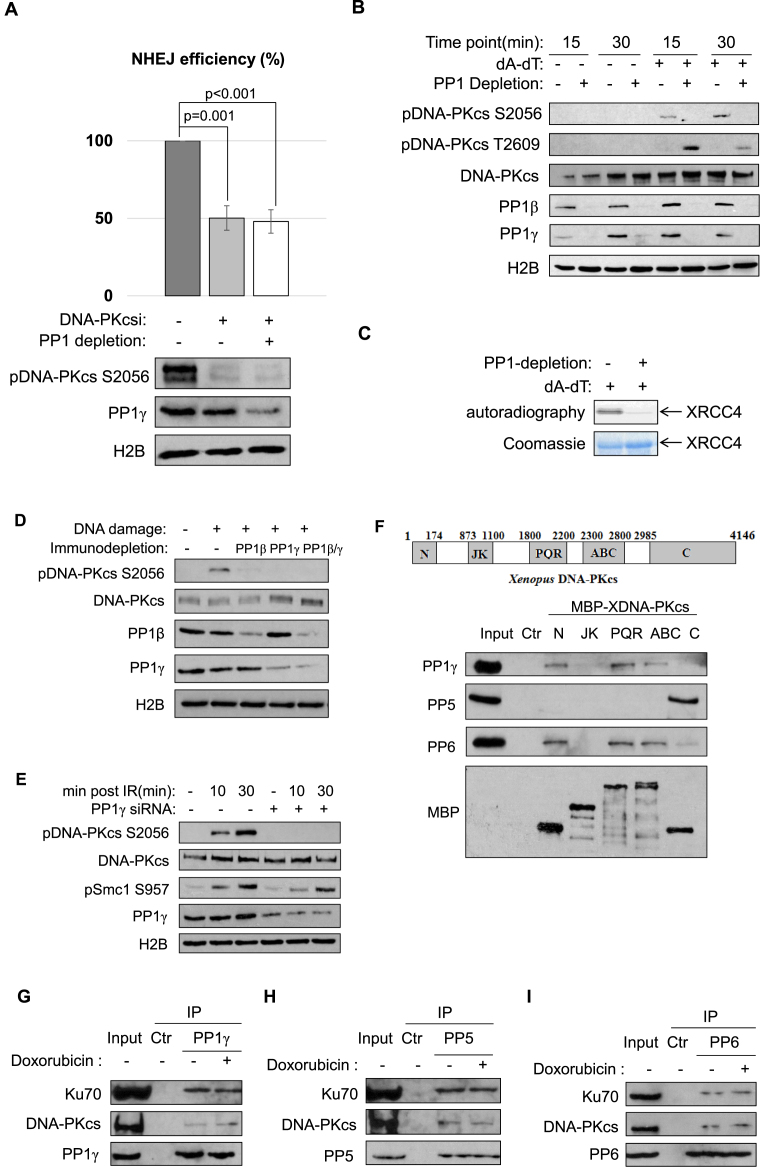Figure 3.
PP1 functions in NHEJ via regulation of DNA-PKcs. (A) The linearized NHEJ template was repaired in Xenopus egg extracts, as in Figure 2B. The extracts were depleted of PP1 (using the PP-binding motif of PNUTS, as in Figure 2A), or treated with a DNA-PKcs inhibitor (NU7441, 20 uM), as indicated. The repair efficiency, measured by colony formation, is shown. Extract samples were analyzed by immunoblotting for DNA-PKcs phospho-S2056, PP1γ and H2B. The experiment was performed at least three times, and the results are shown as the mean values and standard deviations. Statistical significance was analyzed using an unpaired two-tailed Student's t-test. (B) Xenopus egg extracts with or without PP1 depletion (using the PP-binding motif of PNUTS) were treated with 20 ng/μl of (dA-dT)70 as indicated. Immunoblots of DNA-PKcs phospho-S2056, DNA-PKcs phospho-T2609, DNA-PKcs, PP1β, PP1γ and H2B are shown. (C) In vitro DNA-PKcs kinase assay was performed using XRCC4 as substrate, as described in Materials and Methods. The autoradiography and Coomassie stain of XRCC4 are shown. (D) Xenopus egg extracts were immunodepleted of PP1β, PP1γ or both. The extracts were treated with (dA-dT)70 for 30 min, and analyzed by immunoblotting for DNA-PKcs phospho-S2056, DNA-PKcs, PP1β, PP1γ and H2B. (E) HeLa cells were transfected with control or PP1γ siRNA, treated with 10 Gy IR, and incubated as indicated. Immunoblots of DNA-PKcs phospho-S2056, DNA-PKcs, Smc1 phospho-S957, PP1γ and H2B are shown. (F) Five segments of DNA-PKcs (N, JK, PQR, ABCDE (ABC) and C) were expressed with MBP-tag, and purified on amylose beads, as described in Materials and Methods. The beads were then incubated in HeLa cell lysates, re-isolated, and analyzed by immunoblotting. The ‘Ctr’ sample was a mock pull-down using empty amylose beads. (G–I) Immunoprecipitation of PP1γ (G), PP5 (H) and PP6 (I) was performed in the lysates of HeLa cell with or without doxorubicin treatment. The lysate input, control IP with blank beads, and PP1γ IP products were analyzed by immunoblotting for DNA-PKcs, Ku70 and PP1γ, PP5 and PP6, as indicated.

